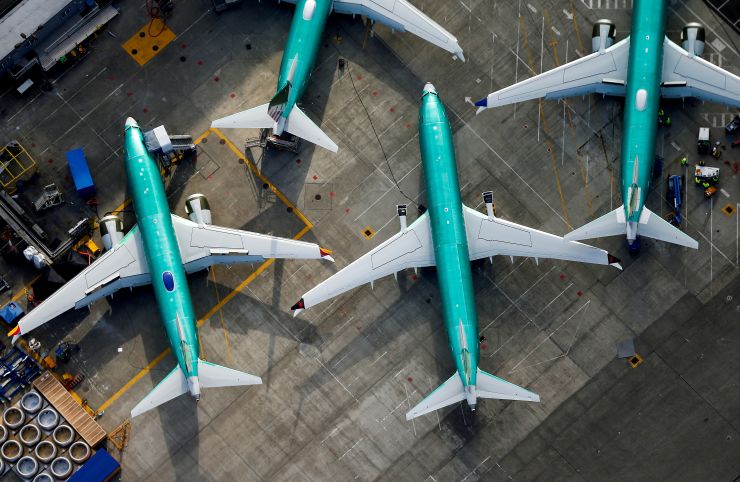
What started as a nightmare scenario – two crashes of the same type of jet within five months that killed 346 people – has turned into a global aviation chess game of the highest stakes.
The Boeing 737 Max has been grounded worldwide following the second crash, in March, and there is no indication when it will be allowed to fly again. The Chicago-based manufacturer is addressing issues with the flight-control system that appears to have played a role in both the crash of Lion Air Flight 610 in Indonesia and Ethiopian Airlines Flight 302 in Ethiopia. Boeing executives have said they are planning for the jet to come back early in the fourth quarter of this year, but nothing has been confirmed, and regulators still must sign off.
On Monday, new Federal Aviation Administration Administrator Stephen Dickson said during his swearing-in ceremony the return would not be rushed.
“This plane will not fly in commercial service again until I am completely assured that it is safe to do so,” he said. “The FAA is not following any timeline for returning the aircraft to service. Rather, we are going where the facts lead us and diligently ensuring that all technology and training is present and correct before the plane returns to passenger service.”
In the meantime, airlines have canceled thousands of flights on both the Max 8, the specific aircraft involved in the crashes, and Max 9, another aircraft in the series; scrapped routes; deserted airports; and taken financial hits amounting to hundreds of millions of dollars. Carriers are adjusting their fleets and schedules to not only make up for the planes that are out of service, but also compensate for the new planes that were on order that will now be delayed.
Even with those disruptions, consumers have thus far largely been shielded because this new model was not yet ubiquitous. Although Boeing says the 737 Max was its fastest-selling aircraft, with about 5,000 orders from more than 100 customers, fewer than 400 have been delivered to airlines around the world. According to Bloomberg, just 3 percent of the mainline fleet in the United States is made up of the aircraft. Still, the aviation industry is scrambling, and it’s getting more likely that everyday travelers might feel the pinch.
These are some of the developments in the industry that have been most likely to affect travelers:
March 24, 2019: American Airlines extends cancellations through April 24, announcing that it expects to cancel 90 flights a day. The airline operates 24 Boeing Max planes. Southwest Airlines, which has 34 of the aircraft, says the following day that it has an average of 130 cancellations a day out of more than 4,000 flights systemwide.
April 11: Southwest says it is removing the aircraft from its schedule through Aug. 5, resulting in about 160 flight cancellations a day, USA Today reports.
April 14: American Airlines again extends cancellations, this time through Aug. 19. The carrier says the move will affect about 115 flights a day. United, which has 14 of the jets, follows suit and stretches cancellations into early July after trying to minimize the number of flights it would cut, CNBC reports.
May 7: A survey of 1,765 fliers by Barclays, the investment bank, showed that 52 percent of respondents said they would prefer to fly on a different type of plane. Just 20 percent said they would fly on a 737 Max as soon as they returned to the skies, while 39 percent said they would return within a few months, and 44 percent said they would wait a year or more.
June 26: During testing, the FAA identifies a new potential issue related to the flight-control computer that could delay the jet’s return even longer.
July 2: Media reports reveal that American has temporarily axed a daily nonstop flight between Dallas and Oakland, Calif., because of the Max grounding. The Points Guy, an airline news site, reports that Southwest has suspended at least 13 routes because of the ordeal.
July 12: United announces plans to pull Max flights from its schedule through Nov. 3. The airline says it expects to cancel nearly 8,200 flights between July and November as a result. American follows, extending cancellations through Nov. 1. Nearly a week later, Southwest removes the Max from its schedule through Nov. 2, resulting in 180 fewer flights a day.
July 15: Facing uncertainty over the aircraft’s future, budget carrier Ryanair says it is deciding which airports it will fly to less frequently and which it will cut altogether, CNN reports.
July 24: Boeing reports its worst quarterly loss in history: $3.38 billion. The company warns that it may have to suspend production of the 737 Max after slowing down production earlier.
July 25: Southwest pulls out of Newark Liberty International Airport altogether, consolidating its regional operations at LaGuardia in New York City. Executives say the airline will remove the Boeing Max from the schedule through Jan. 5, 2020.
July 30: CNN reports that United will temporarily cut its daily round-trip flight between Chicago and Leon, Mexico, effective Sept. 3.
Aug. 13: Blaming the grounding, Norwegian Air cuts flights between Dublin and three North American cities. The budget airline says it will no longer serve New York’s Stewart Airport, in the Hudson Valley; T.F. Green Airport, near Providence, R.I.; and John C. Munro Hamilton International Airport in Hamilton, Ontario.
Aug. 13: Boeing reports that no one ordered a Max jet in July, the fourth straight month without a new order, CNBC reports.
